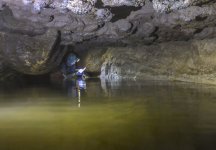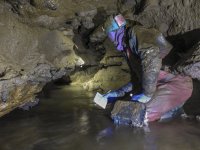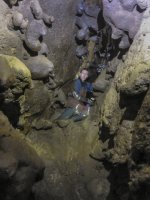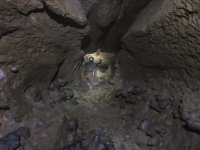It’s been a challenging year for digging in the North York Moors so far, but lots happening.
Attendance at our Wednesday digging session has remained at record highs, often with 8-12 people turning out each week from York Caving Club and the North York Moors Caving Club. Since May, efforts have been split across two separate projects, with the teams reuniting at The Crown in Hutton-le-Hole afterwards for sandwiches, chips, and beer.
One team (including myself) has been focused on Jenga Pot, where we had arranged two dates for cave divers to come and have a go at Sumps 4c and 5, which offer great potential. To gain access to these sumps, which are in the 2020 Covid Extensions, we need to pump out Sumps 1 and 2 (Sump 3 no longer needs pumping thanks to an overhead bypass we dug last year).
Work here didn’t start until April once we felt confident the surface river had flooded for the last time until the end of summer (the sumps refill instantly if the river floods).
In theory, pumping these sumps should be as simple as firing up a generator on the surface, and both underground pumps should jump into action. About three tanks full of petrol would see these sumps emptied, without us even having to go underground! Or so we hoped…
Things did not go totally to plan. The generator circuit breakers tripped when both pumps were run simultaneously, despite no problems over the last two years. We concluded that either the pumps were drawing more current than they should be, the generator was not delivering the current it once did, or the circuit breaker was tripping too readily. We made progress pumping one sump at a time, but this was painfully slow, and progress was reset when an unexpected mid-May flood of the river refilled the sumps, sending us back to square one again.
The first date for the divers had been arranged for 3rd June, so the race was on to get the sumps pumped again to enable easy access. We even brought a second generator to run both pumps at once, and we finally seemed to be making progress.
We arrived on Wednesday 1st June, expecting both sumps to be empty. We headed underground to check the state of play, only to find Sump 1 still half full, still sumped at the far end, and no noise coming from the pump and no pressure in the pipe. The diving was off!
We turned up the following week with a new pump for Sump 1 (it has been in there since 2014, so we assumed it had finally failed) only to then identify the issue as a loose connection on the surface. A quick fix, so we refocused our efforts on the second diving date of 1st July.
Sumps 1 and 2 were quickly emptied. By now, our usual generator seemed to be running both pumps at once, so the earlier issue, whatever it was, seemed to have magically sorted itself out. Things were finally looking positive and getting divers to sumps 4-5 on 1st July seemed an inevitability.
We even set to work improving the system, replacing connectors, drilling small hooks throughout the cave to support the cables and stop them getting crawled on, and building a double-ammeter to allow a diagnostic readout on the surface of the current being drawn by each pump.
On 28th June we took a trip underground to confirm everything was in place, finding sumps 1 and 2 still empty from the week before. We made quick progress down to sumps 4 and 5. To our surprise, and despite the very dry conditions, the percolation stream flowing out from sump 4 and down to sump 5, was going like a train. The dug squeeze bypassing sump 4 to reach sump 4c, one of the dive targets, was full of water and would need extensive bailing, and the small stream-level squeeze to reach sump 5, which has been easily passable for the last three years, was mostly sumped! This is, by far, the wettest we have seen this streamway, and it took us rather by surprise.
Unfortunately, this meant cancellation of the diving once again, and probably the end of all efforts for this year because we are only a few months away from the end of the dry season.
We will need to dig a channel to prevent the crawl to Sump 4c from filling up like a U-bend, and we will need to mine over the top of the squeeze to sump 5 to enable more guaranteed access, given the rather unpredictable nature of the streamway here. At best we are looking at 2024 for the next diving efforts here now, which is a real disappointment.
Efforts last year to dive Sump 4 (subsequenty bypassed by overhead dig to reach sumps 4b/4c)
As for sumps 6-7, they are much further into the cave, beyond a low-airspace duck, which we know doesn’t drain sufficiently until late summer. They are great targets, being spacious, clean flowing sumps with enormous potential including a likely valley-to-valley connection. However, it will be a long, hard carry for gear and I think the recent challenges just getting divers to sumps 4c/5 (which were supposed to be the easy ones) has given us a reality check. The people-power needed and the high physical challenges associated to reaching and diving these further sumps might be insurmountable. We are going to focus instead on a dig in the next valley which might enable a new surface entrance.
Elsewhere, at our other dig near the hamlet of Cawthorn, 6.5km east of Jenga Pot, things are progressing very nicely. This is already the second active cave system in the North York Moors, and throughout winter takes quite a decent stream, flowing along a boulder filled passage. With summer here, and this stream not flowing, this provides a good chance to make more pleasant progress.
We posted an earlier update on this project here:
Up in the North York Moors, we have been treated to some great discoveries over the last decade, including a 1km+ extension to Jenga/Excalibur Pot in 2020. However, all open and obvious leads in Jenga/Excalibur are now exhausted (except for the four sumps which await divers and are sure to add...

ukcaving.com
This year started with the cave about 65m long and follows a large (2m+ wide, 1m+ high) water-formed passage. These proportions are only evident in a few places, because for the most part, it is just a continuous boulder ruckle. Progress is being achieved through mining, following the route of water, with an encouraging and reliable draught. Every few weeks, efforts are rewarded with a few metres of open progress to yet more boulders with tantalising space beyond. The passage shows no signs of ending... but neither do the boulders!
Currently, the Cawthorn team are arriving at the pub optimistic about progress, and there is a feeling that the dig could ‘go’ at any time. This is particularly true if we can get deeper into the hillside and into better quality limestone where the roof has been less prone to collapse.
The vertical range to the suspected resurgences is over 100m, and the horizontal range is 3-4km. The passage takes a generous stream in wet weather, and the draught is reliable. Hope remains high that this could be the start of the next big North York Moors thing, although nobody is keen to wager on whether it will be next week or next decade that the breakthrough will happen.
Whatever happens, the North York Moors continues to carve a small, but proud place on the speleological map of the United Kingdom, and more discoveries seem inevitable.









